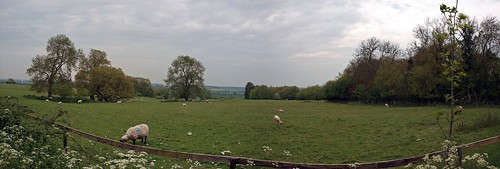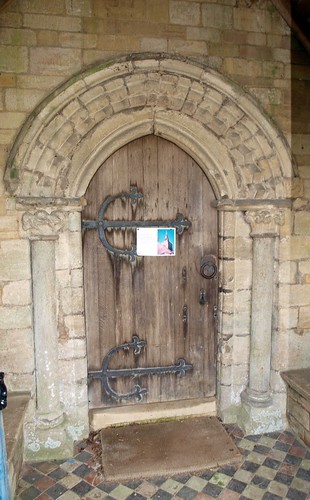ST ANDREW. The steeple is rather underfed. The narrow arch towards the nave is of three chamfers and dies against the imposts. This, and the whole tower, is Dec. Recessed Perp spire; shortish and with two tiers of lucarnes. Dec also the S arcade of four bays (standard elements), and the chancel, the S aisle, the clerestory, and the straight-headed N nave windows. The S aisle E window still has intersecting tracery. Only the S doorway is much earlier. It is partly late C12 and partly early C14. Outer arch with zigzag at r. angles to the wall. Inner arch pointed. The capitals of the colonnettes have one normal stiff-leaf, the other oddly stylized and interlocked stiff-leaf. - BELLS. Three by Henry Jordan, i.e. c.1450-60. - ALTAR CLOTHS. One large mid C16 piece, Flemish, with the Virgin and angels, and one small, early C17 one, also Flemish, with a hunting scene. -- PLATE. Cup of 1569-70; Paten on foot of Britannia silver 1697-8. - MONUMENTS. Mrs Mary Kinyon d. 1714, wrongly assembled, with a bust on top. - Sir John Cotton d. 1752. Large, but mostly an inscription plate.
STEEPLE GIDDING. There is not much of the steeple and little of Gidding. A village on a hill, it was loved by Nicholas Ferrar, the saint of Little Gidding, who used to walk over for service. It must all be much as he saw it, for nothing could be more peaceful than the fields round about Steeple Gidding’s church.
It has a tiny spire, three bells that have been ringing since the 15th century, and an English doorway with beautiful capitals, set in a Norman arch. There is an altar cup made before the Great Armada, a stone coffin lid with ornamental crosses 700 years old, a 16th century font, and a marble bust of Mary Cotton of 1714.
Carefully preserved by the rector is something made by a lady long ago, beautiful altar linen exquisitely worked by her clever fingers. There is a cloth with a hunting scene thought to be 17th century Flemish work; but one showing angels, a Madonna under a canopy, and a pot of lilies on a table was worked soon after Queen Elizabeth was crowned, and is one of the fine possessions of the county.
It has a tiny spire, three bells that have been ringing since the 15th century, and an English doorway with beautiful capitals, set in a Norman arch. There is an altar cup made before the Great Armada, a stone coffin lid with ornamental crosses 700 years old, a 16th century font, and a marble bust of Mary Cotton of 1714.
Carefully preserved by the rector is something made by a lady long ago, beautiful altar linen exquisitely worked by her clever fingers. There is a cloth with a hunting scene thought to be 17th century Flemish work; but one showing angels, a Madonna under a canopy, and a pot of lilies on a table was worked soon after Queen Elizabeth was crowned, and is one of the fine possessions of the county.



No comments:
Post a Comment